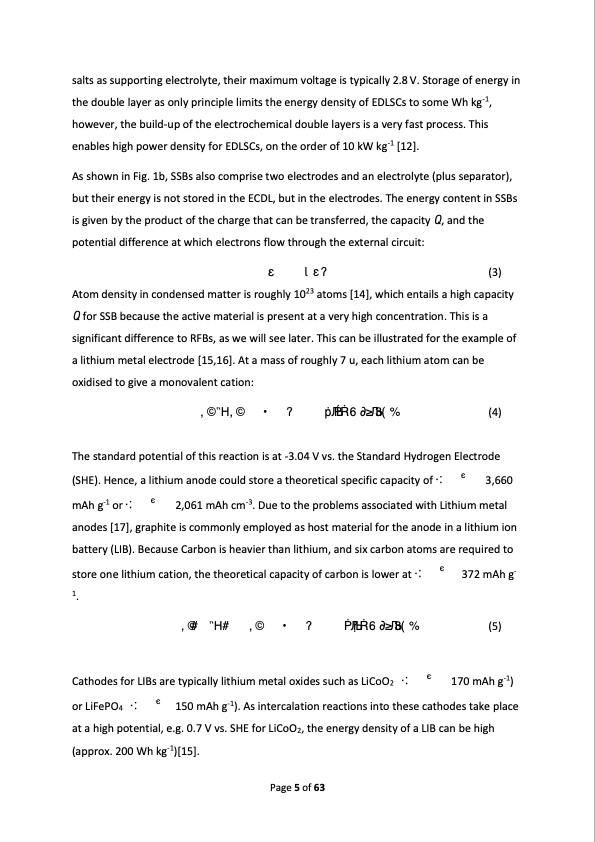
PDF Publication Title:
Text from PDF Page: 005
salts as supporting electrolyte, their maximum voltage is typically 2.8 V. Storage of energy in the double layer as only principle limits the energy density of EDLSCs to some Wh kg-1, however, the build-up of the electrochemical double layers is a very fast process. This enables high power density for EDLSCs, on the order of 10 kW kg-1 [12]. As shown in Fig. 1b, SSBs also comprise two electrodes and an electrolyte (plus separator), but their energy is not stored in the ECDL, but in the electrodes. The energy content in SSBs is given by the product of the charge that can be transferred, the capacity Q, and the potential difference at which electrons flow through the external circuit: � ��� (3) Atom density in condensed matter is roughly 1023 atoms [14], which entails a high capacity Q for SSB because the active material is present at a very high concentration. This is a significant difference to RFBs, as we will see later. This can be illustrated for the example of a lithium metal electrode [15,16]. At a mass of roughly 7 u, each lithium atom can be oxidised to give a monovalent cation: �� ��� � � ����������� (4) The standard potential of this reaction is at -3.04 V vs. the Standard Hydrogen Electrode (SHE). Hence, a lithium anode could store a theoretical specific capacity of � � 3,660 mAh g-1 or � � 2,061 mAh cm-3. Due to the problems associated with Lithium metal anodes [17], graphite is commonly employed as host material for the anode in a lithium ion battery (LIB). Because Carbon is heavier than lithium, and six carbon atoms are required to store one lithium cation, the theoretical capacity of carbon is lower at � 1. ��� � � �� � � ���� � ��� ��� Cathodes for LIBs are typically lithium metal oxides such as LiCoO2 � � � 372 mAh g- (5) 170 mAh g-1) or LiFePO4 � � 150 mAh g-1). As intercalation reactions into these cathodes take place at a high potential, e.g. 0.7 V vs. SHE for LiCoO2, the energy density of a LIB can be high (approx. 200 Wh kg-1)[15]. Page 5 of 63PDF Image | Redox Flow Batteries Concepts Chemistries

PDF Search Title:
Redox Flow Batteries Concepts ChemistriesOriginal File Name Searched:
5870EAF5-2D70-44C8-A0A7-62D3A1462269.pdfDIY PDF Search: Google It | Yahoo | Bing
Salgenx Redox Flow Battery Technology: Salt water flow battery technology with low cost and great energy density that can be used for power storage and thermal storage. Let us de-risk your production using our license. Our aqueous flow battery is less cost than Tesla Megapack and available faster. Redox flow battery. No membrane needed like with Vanadium, or Bromine. Salgenx flow battery
| CONTACT TEL: 608-238-6001 Email: greg@salgenx.com | RSS | AMP |